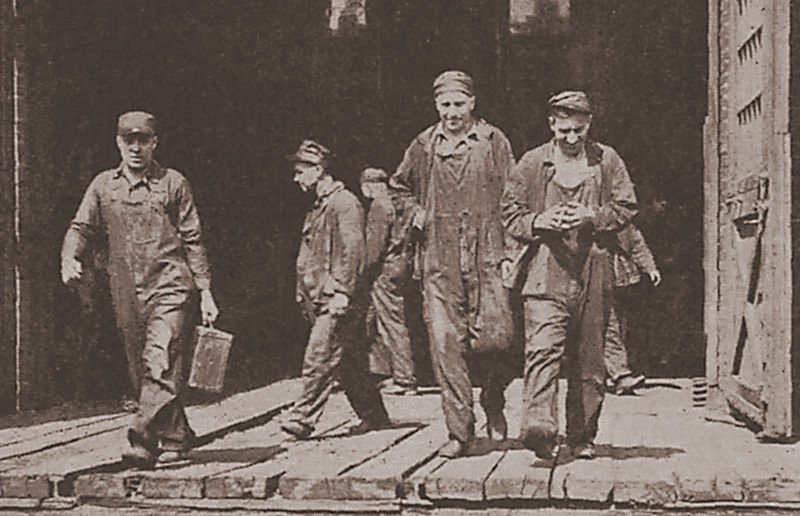

Railroad workers walking off the job in the July 1922 strike. Photo from Labor Herald [Chicago] Aug. 1922.
![Railroad workers walking off the job in the July 1922 strike. Photo from Labor Herald [Chicago] Aug. 1922.](https://www.workers.org/wp-content/plugins/accelerated-mobile-pages/images/SD-default-image.png)
![Railroad workers walking off the job in the July 1922 strike. Photo from Labor Herald [Chicago] Aug. 1922.](https://www.workers.org/wp-content/uploads/2014/02/railworkers_0603-300x193.jpg)
Railroad workers walking off the job in the July 1922 strike. Photo from Labor Herald [Chicago] Aug. 1922.
President Warren G. Harding and his incredibly corrupt administration smashed the strike. At least 10 workers were killed by the National Guard and private detectives across the country.
Attorney General Harry Daugherty got federal Judge James Wilkerson to issue a sweeping injunction against the workers. Union leaders were forbidden from even giving newspaper interviews. Daugherty was later forced to resign because of the Teapot Dome scandal.
Safety meant nothing to railroad bosses like Pennsylvania Railroad President Samuel Rea. With skilled machinists striking, 71 percent of locomotives failed monthly inspections from August through September 1922.
Instead of negotiating with union workers, Rea hired over 16,000 gunmen to break the strike of nearly 20,000 employees at the company’s shops in Altoona, Pa., the largest in the world.
Although the railroad workers were finally defeated, their great struggle forced the capitalist government to pass the 1926 Railroad Labor Act.
Scabbing within the labor movement
It wasn’t just the Harding administration that broke the 1922 strike. While workers in the railroad shops went on strike, workers operating the trains — locomotive engineers and firemen, conductors and brakeman — continued to work.
Railroad management was able to split the workers. Union misleaders forgot that “an injury to one is an injury to all.” Instead of fighting together against the railroad companies, leaders of the better paid workers in the “operating crafts” ignored the rest of rail labor.
Many engineers and conductors wanted to support the workers in the shops. The defeat of the 1922 strike helped lead workers to form industrial unions in the 1930s, instead of being split up into different crafts.
The worst scabbing came from racism in the labor movement. Black workers were kept out of railroad unions. Eugene Debs wasn’t able to get the American Railway Union, which led the 1894 Pullman strike, to allow African Americans to join. It wasn’t until 1937 that the Pullman Company signed a contract with the Brotherhood of Sleeping Car Porters, led by A. Philip Randolph.
According to historian William H. Harris “from 1928 to 1949, not a single black person found employment on a class 1 railroad as fireman, brakeman, trainman, or yardman.” (“The Harder We Run: Black Workers Since the Civil War)
Ironically, railroad companies had used enslaved Africans to lay 9,000 miles of track in the South before the Civil War and Black prisoners to build more miles afterwards. One of the prisoners was John Henry, who was worked to death by the Chesapeake and Ohio railroad, now part of CSX.
Union busting and lynching
The 1922 rebellion of railroad workers was the last chapter in a strike wave that followed World War I and the Russian Revolution. In 1919 one out of seven industrial workers in the U.S. went out on strike. Among them were 365,000 steel workers led by future communist leader William Z. Foster. Many of the striking workers were immigrants.
Corporations and their government struck back. Most strikes and organizing drives were defeated. The U.S. Supreme Court upheld “yellow dog” contracts that forced workers to agree not to join a union. Supreme Court Chief Justice and former President William Howard Taft threw out a law that limited child labor.
Corporations also funded the revival of the Ku Klux Klan, which experienced a rise in membership to more than 3 million during this period. One year before the railroad strike, white racist mobs, led by the KKK, destroyed 35 blocks of a thriving African-American neighborhood of Greenwood in Tulsa, Okla., killing hundreds of people.
This wave of racist attacks and lynch mobs fueled the growth of the Universal Negro Improvement Association whose membership also numbered in the millions under the leadership of the Honorable Marcus Garvey.
Censoring labor history
During the 1920s, U.S. railroads employed more than 2 million workers. Hardly 200,000 workers have railroad jobs today.
Job cuts included railroad shops being shutdown from Livingston, Mont., to Paducah, Ky. Only 1,100 railroaders remain in the Altoona shops, now owned by the Norfolk Southern railroad. This outfit is paying jitney drivers just $8 an hour to carry other railroaders to its Croxton, N.J., yard.
Norfolk Southern wouldn’t let the Pennsylvania Labor Historical Society place a plaque commemorating the 1922 strike at Altoona’s Juniata Locomotive Shops. The Blair Bedford Central Labor Council accepted it instead. Railroad management claimed the plaque served “no useful purpose.” (Altoona Mirror, June 2010)
This is in the tradition of strikebreaker Samuel Rea, who refused to allow a plaque to be posted in New York’s Pennsylvania Station to honor the workers who died building it. It’s unknown how many workers were killed building the station and the tunnels leading to it. (Jill Jonnes, “Conquering Gotham”)
Today’s labor movement can turn things around. Workers on the Long Island Railroad may be forced to go on strike in March. If compelled to strike, women and men will stand united on the picket lines, Asian, Black, Latino/a, Native and white.
Millies is a member of the American Train Dispatchers Association and Transportation Communications Union.
By John Catalinotto, managing editor, Workers World newspaper Adapted from the author’s presentation at a…
The following is part one of a talk given by the author to a meeting…
The island nation of Cuba has consistently struggled with one economic barrier above all others:…
Dozens of activists responded to a call by the United Farm Workers (UFW) for an…
In its ongoing genocidal campaign against the Palestinian people, Israel used drones May 2 to…
Palestinian and regional factions condemned the Israel Occupation Forces’ attack today on the Al-Dameer (Conscience)…